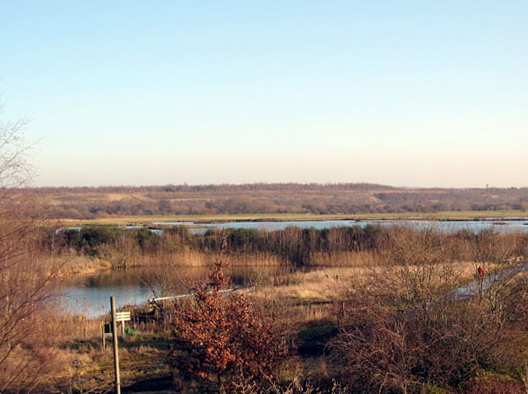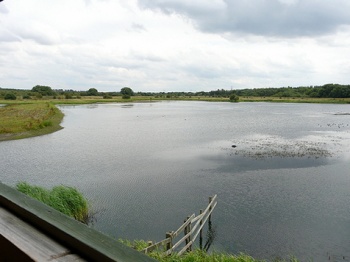| This article is incomplete. This article is missing one or more sections. You can help the BirdForum Opus by expanding it. |
Overview
This RSPB reserve, South of the River Dearne, between Barnsley and Doncaster, in South Yorkshire, is approx 250 acres in size and is easily reached from both A1 and M1 motorways. For those in a hurry the reserve can be adequately explored in as little as a couple of hours but will repay a leisurely approach.
The habitat is mainly open freshwater, although efforts are ongoing to establish a reed bed on the reserve. There are scrapes and flood meadows for waders, as well as an area set aside as a ringing site.
The reserve is situated on the Dearne Valley flyway, an important route used by birds moving from one side of the country to the other.
Birds
Notable Species
Old Moor has a significant population of Eurasian Tree Sparrow that has been helped with a co-ordinated nestbox scheme. The reserve's wader population includes thousands of wintering Northern Lapwing and European Golden Plover. A small number of Firecrest have been sighted around the perimeter of the reserve during winter. Great Bittern are an increasingly common sight at the reedbed hides during the winter, and a pair successfully bred for the first time in 2012. Pied Avocet and Mediterranean Gull are also among the rarer breeders on the reserve in recent years.
Rarities
The reserve has attracted several rare birds over the years, Great White Egret on at least two occasions and in 2008 was all too briefly visited by a Little Swift. Recent notable visitors have included Eurasian Spoonbill, Temminck's Stint, Black Tern, Green-winged Teal, Iceland Gull and a wintering Garganey.
Check-list
Birds you can see here include:
Mute Swan, Whooper Swan, Greylag Goose, Canada Goose, Common Shelduck, Eurasian Wigeon, Gadwall, Eurasian Teal, Mallard, Shoveler, Common Pochard, Tufted Duck, Common Goldeneye, Goosander, Ruddy Duck, Common Pheasant, Red-legged Partridge, Little Grebe, Great Crested Grebe, Great Cormorant, Great Bittern, Little Egret, Grey Heron, Osprey, Eurasian Sparrowhawk, Common Buzzard, Common Kestrel, Peregrine Falcon, Eurasian Hobby, Moorhen, Eurasian Coot, Water Rail, Eurasian Oystercatcher, Little Ringed Plover, Common Ringed Plover, European Golden Plover, Northern Lapwing, Pied Avocet, Curlew Sandpiper, Dunlin, Ruff, Common Snipe, Black-tailed Godwit, Eurasian Curlew, Common Sandpiper, Green Sandpiper, Common Greenshank, Common Redshank, Wood Sandpiper, Black-headed Gull, Mediterranean Gull, Common Gull, Lesser Black-backed Gull, European Herring Gull, Great Black-backed Gull, Common Tern, Feral Pigeon, Stock Dove, Common Woodpigeon, Eurasian Collared Dove, Little Owl, Tawny Owl, Barn Owl, Common Swift, Common Kingfisher, Green Woodpecker, Great Spotted Woodpecker, Sand Martin, Northern House Martin, Barn Swallow, Grey Wagtail, Pied Wagtail, Bohemian Waxwing, Eurasian Wren, Hedge Accentor, European Robin, Eurasian Blackbird, Song Thrush, Redwing, Fieldfare, Mistle Thrush, Sedge Warbler, Eurasian Reed Warbler, Blackcap, Lesser Whitethroat, Common Whitethroat, Common Chiffchaff, Willow Warbler, Goldcrest, Firecrest, Long-tailed Tit, Blue Tit, Coal Tit, Great Tit, Willow Tit, Eurasian Magpie, Eurasian Jackdaw, Rook, Carrion Crow, European Starling, House Sparrow, Eurasian Tree Sparrow, Chaffinch, Brambling, European Greenfinch, European Goldfinch, Eurasian Siskin, Eurasian Linnet, Lesser Redpoll, Common Bullfinch, Yellowhammer, Reed Bunting
Other Wildlife
Many species of butterfly, moth, dragonfly and damselfly can be found on site. Mammals that can sometimes be seen in the area include red fox, bown hare, weasel and water vole, and grass snakes can sometimes be found in the ponds.
Site Information
History and Use
The reserve is relatively new, opening in 1998 under Barnsley Metropolitan Council ownership and originally known as Old Moor Wetland Centre, with the management being taken over by RSPB when BMC had to pull out. The reserve takes in the older Wath Ings reserve, which accounts for approx 1/5 of the 250 acres, and is largely built upon what was once a coal stockpiling area for the Wath Manvers colliery complex.
The work on extending Wath Ings and turning it into Old Moor was only economically possible when the surrounding area came under a regeneration plan and huge quantities of soil were required to reclaim the old colliery spoil heaps. This meant that the necessary material could be dug out from the Old Moor site, creating the Main Lake and Wader Scrape, and transported straight to the spoil heaps as required. It took 7 years for the reserve to take shape, during which time some 700,000 tonnes of soil were moved without the need to use local roads.
Parts of the old farm buildings on the site may date back as far as the 13th century, although most are from the 18th century. It is possible that the older parts may represent all that is left of the Broomhill Manor that is mentioned in land records of the time.
Areas of Interest
The heart of the reserve is the Main Lake, which has varying depths and several islands for nesting birds. The Wader Scrape is east of the main lake and the water levels are managed to provide fresh mud to attract waders. The Wath Ings area has been largely untouched and is a mix of open water and mud spits, with wet grassland further east.
Access and Facilities
The reserve is open 363 days per year, opens at 9.30am and closes at 4.00pm (1st Nov to 31st Jan) or 5.00pm (1st Feb to 31st Oct). The reserve car park closes approx 15 minutes after the reserve closes. On Christmas Day and Boxing Day the reserve is closed.
There is an entrance charge for non RSPB members, currently (2009) Adults £2.50 and Children £1.25.
A regular bus service (number 200) runs between Swinton and Mexborough, stopping outside the reserve - see here for timetable.
The Café is open each day the reserve is open and has both hot and cold food and drinks available.
There are toilets on site including those suitable for the disabled.
Grid reference: SE422022
Contact Details
01226 751593
References
Yorkshire Birding Vol 6 Issue 4
Old Moor Wetland Centre Information sheets 1 & 2 produced by Barnsley Metropolitan Council
External Links
Old Moor entrance on Streetmap
Content originally posted by Keith Dickinson 20 January 2009





